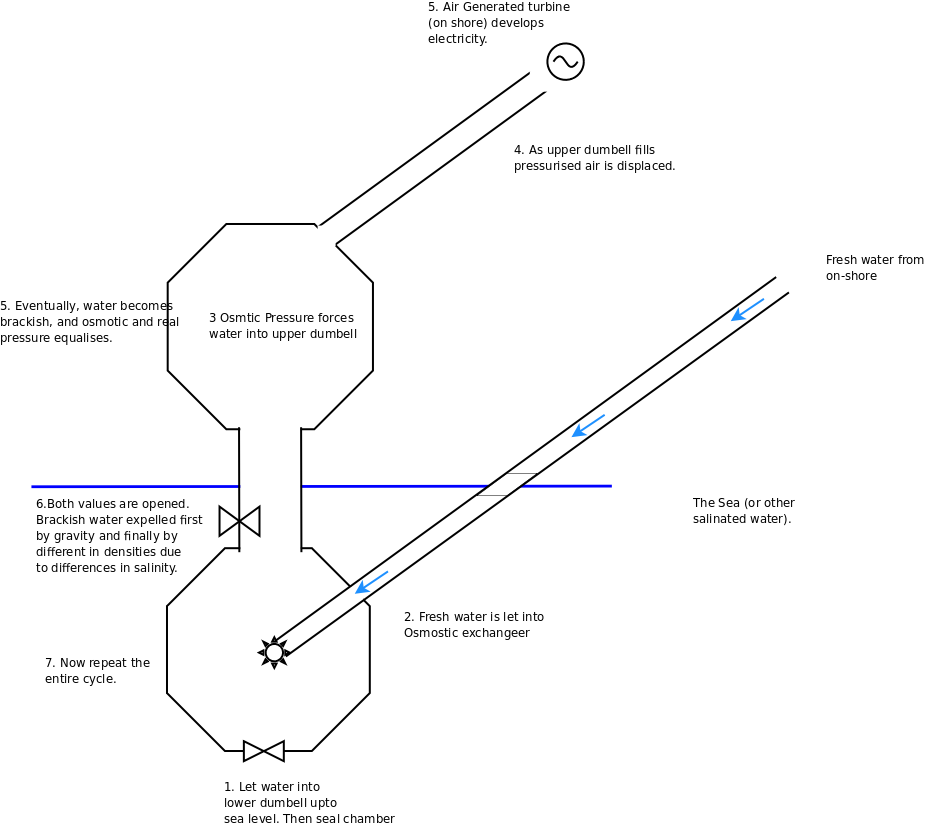
The OsmoticDumbell is my current favourite technique for exploitation of OsmoticPower. This is still not a perfect system, as it works in batch, rather than continuously. However it has relatively low geographic requirements; so long as there is a source of fresh water near to a source of salt water, then this should work.
 |
| Diagram of an Osmotic Dumbell |
The key idea here is not to use water pressure or flow to generate electricity, but rather to use air displaced by water to drive the turbine. This has two key advantages: first, air turbines can be significantly more efficient than a water based one because they can rotate faster; secondly, by using air there are very few moving parts in this system which need to be immersed in sea water, which has implications for maintenance of the system, as any precision parts of going to be sensitive to rust.
The system looks like a giant dumbell—two large tanks joined by a pipe—with one tank (mostly) underwater, and one (mostly) overwater. Fresh water is piped into the lower tank, from some handy nearby source. Somewhere upstream from the mouth of a river would be fine. At the end of the pipe is an OsmoticExchanger—a device presenting a large surface area of semi-permeable OsmoticMembrane. Ideally, this should be entirely passive, requiring no energy.
The system works in batch as follows:
The actual requirements for this system are quite mininal. You need salt water and fresh water, as close together as possible. A relatively quick descending sea bed would be nice, so that the pipes to shore can be as short as possible. The system should be relatively silent (the turbine might be quite loud, but this can be inside, or somewhere underground—it's not open to the atmosphere), it can run all year around, except during such extreme drought that the rivers dry up 1.
There are some problems with the system. The keyone is what happens if the fresh water is not entirely fresh. In this case, the impurities will build up in the OsmoticExchanger, reducing the efficiency of the entire system. If the fresh water supply comes from a higher elevation that the salt water (which, lets face it, is quite likely), then this pressure can be used to flush the backend by gravity. Essentially, you put another pipe into the OsmoticExchanger which comes out vents to air above the sea. This can be closed off for most of the time, and then opened while the brackish water is being expelled from the dumbell. The water should circulate, flushing any impurities which have gathered.
I'm really fond of this system. There is plenty of technological experience which can reused for this system. The lower half of the dumbell is, basically a low grade submarine. Or you could use oil rig experience. The only submerged moving parts are values—again this is well understood technology. And the system is arbitrarily scalable, and offers many different arrangements; there could be a couple of huge tanks, or many smaller ones depending the requirements of other users of the sea. You could be really cool here, and build the entire system on the same foundations as being used for OffShoreWindFarm.
The key problem with the system, like all OsmoticPower systems is getting a good enough OsmoticMembrane within the OsmoticExchanger.
1. Actually, you can get really sneaky when this happens; by reversing the system and using the turbine to pump air into the upper tank, you can reverse the whole system to become a desalination plant: energy in, fresh water out.